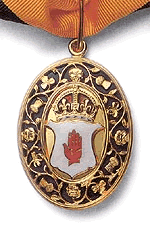
|
The Complete Guide to the British Peerage & Baronetage |
____________________________________________________________________________________________________________
The Baronetage

The badge of a Baronet of the United Kingdom
Baronets of Nova Scotia or Scotland
Baronets of the United Kingdom
The hereditary Order of Baronets was created by patent in England by King James I in 1611, extended to Ireland by the same monarch in 1619, and first conferred in Scotland by King Charles I in 1625.
At the institution of the Order of Baronets many of the leading non-titled gentlemen of the kingdom were selected for the dignity. The first eighteen of the Baronets of England, all created on 22 May 1611 and of which eight survive (five now held by peers), were drawn from the principal landed families, and were among the best descended gentlemen of the kingdom. The list was headed by a name illustrious more than any other for the intellectual pre-eminence with which it is associated - the name of Bacon.
For some time the possession of territorial influence was the main qualification and the Order in both England and Ireland was confined principally to country gentlemen of property and descent. But in more modern days the Order was enlarged and made to include men who have raised themselves and their families to greatness by their pre-eminence in science, literature, commerce or arms. It is to be regretted, therefore, that with the exception of Sir Denis Thatcher in 1991, there have been no new creations in the Order of Baronets since 1964.
BARONETS OF NOVA SCOTIA OR SCOTLAND
The Order of Baronets in Scotland, instituted in 1625, was originally connected with Sir William Alexander's scheme for colonising Nova Scotia. The number was not to exceed 150, the sum payable for the honour was £3,000 (equivalent to about £471,000 in 2012 terms), and the patents down to 1638 included a grant of specified lands in Nova Scotia, even though that colony had passed into the hands of the French prior to that date. The latter creations by King Charles I included gentlemen unconnected with Scotland, and in one instance the dignity was granted to a lady, Dame Maria Bolles, of Osberton, Nottinghamshire. In almost all the patents granted by King Charles I the limitation was to heirs male whomsoever; afterwards, though there was some occasional variety, the most usual limitation was to heirs male of the body, bringing Scottish creations into line with creations in England and Ireland.
BARONETS OF GREAT BRITAIN
After the union of Scotland and England, Baronets of England and Nova Scotia ceased to be created, and a new Order of Baronets of Great Britain was instituted, the first letters patent being granted by Queen Anne on 28 June 1707.
BARONETS OF THE UNITED KINGDOM
On 1 January 1801 the union of Ireland with Great Britain took place, and the baronetcies of these two orders ceased to be created. On 20 March 1801 King George III created the first United Kingdom Baronet.
PRECEDENCE OF BARONETS
Baronets are given precedence according to the date of their creations and are placed below Knights of the Garter, the Thistle or St Patrick but above Knights Grand Cross of the other Orders of Chivalry.
INSIGNIA OF BARONETS
The Baronets of England and Ireland (and later those of Great Britain and the United Kingdom) are allowed to bear on their shield as an "honourable augmentation" an inescutcheon of the arms of Ulster (Argent a Hand couped Gules), as a reminder that the fees from the earliest creations of Baronets has been used to promote the Plantation of Ulster. It was first provided that the Baronets of Nova Scotia should in a similar manner bear an inescutcheon of the arms of Nova Scotia on their arms, but in 1629 King Charles I allowed Baronets of Nova Scotia to wear as a personal decoration a badge of the arms of Nova Scotia (Argent a Saltire Azure thereon an Inescutcheon of the Royal Arms of Scotland imperially crowned proper) encircled by the motto Fax mentis honestae gloria (the motto of Henry, Prince of Wales) and suspended from the neck by an orange or tawny riband. It was not until 1929 that Baronets other than those of Scotland were granted a neck badge. This consisted of a shield of the arms of Ulster surmounted by an Imperial Crown and the whole enclosed by an oval border embossed with gilt scroll-work, having for Baronets of England a design of roses, for Baronets of Ireland a design of shamrocks, for Baronets of Great Britain a design of roses and thistles, and for Baronets of the United Kingdom a design of roses, thistles and shamrocks. The badge is suspended from an orange or tawny riband, with a narrow dark blue edge on both sides.
THE STANDING COUNCIL OF THE BARONETAGE
The Honourable Society of the Baronetage was established in January 1898 and was reconstituted in July 1903 as the Standing Council of the Baronetage as a permanent organisation to deal with all affairs concerning the Baronetage.
THE OFFICIAL ROLL
By a Royal Warrant of King Edward VII dated 8 February 1910 an Official Roll was established to be kept at the Home Office. It was further stated "that no person whose name is not entered on the Official Roll of Baronets shall be received as a Baronet, or shall be addressed or mentioned by that title in any civil or military Commission, Letters Patent or other document." The Official Roll is now maintained by the Ministry of Justice.
SUCCESSION TO A BARONETCY
The Standing Council of the Baronetage's web site has full details of the procedure for claiming succession to a Baronetcy. The staff at Cracroft's Peerage are always willing to offer advice on this and to help any claimant prepare the evidential material required by the Registrar of the Baronetage.
Last updated 13 Aug 2012
____________________________________________________________________________________________________________
ã Copyright: Heraldic Media Limited. All rights reserved.